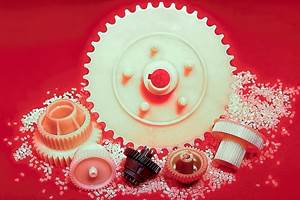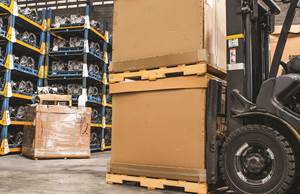2019 SPE Auto Innovation Award Winners
There were many ‘firsts’ with broad transferability.
Spanning nine categories, the winners of the 49th annual Society of Plastics Engineers Automotive Division’s 2019 Blue Ribbon Automotive Innovation Awards (which this editor helped judge) exemplify continued innovation and broad technology transferability in the use of plastics. Once again, thermoplastics and/or thermoplastic composites ruled and additive manufacturing was once again featured for the second year in its own as well as in the aftermarket categories. Here’s a brief look at the nine winners, starting with the grand award winner—also the winner of the Body Exterior category
▪ BODY EXTERIOR: Composite Pickup Box.
This industry first pickup box in carbon-reinforced thermoplastic composite is featured in the 2020 GM’s Sierra LD FST pickup. Teijin’s Serrebo A235Y carbon fiber-reinforced nylon 6 compression molded sheet, produced by Continental Structural Plastics saved 62 lb/28 kg, provided best-in-class impact resistance/durability, and the unpainted UV-stable material eliminated the need for a bedliner, which saves another 40 lb/18 kg).
▪ ADDITIVE MANUFACTURING: Sunglass Bin
Additive manufacturing was used to produce a single tooling insert (lifter) that replaced two conventionally machined lifters to mold an injection molded sunglass stowage bin. This indstry first appears in the 2020 Ford Explorer SUV, and was injeection molded with Celanese’s Celstran PP-GF20-02 LFT-PP by Methode Electronics using the 3D printed H13 steel by RGM Tooling Consultants.. This process enabled design changes to produce a deeper pocket with a heavier undercut that still could be molded without hotspots, warpage, or demolding issues and without needing to switch to a more costly resin. The new deeper bin design also better meets customer requirements while reducing cycle time, molding scrap, tooling maintenance, and improving dimensional stability in the final part.
▪ AFTERMARKET & LIMITED EDITION/SPECIALTY VEHICLES: Multiple Additive Manufactured Components
Additive manufacturing proved the most efficient and cost-effective method for producing 19 parts on the 2020 Jaguar Land Rover LXE SV Project 8 supercar sedan whose total build volume will be limited to 300 cars. Both development and production parts were produced on the same printer platform, which eliminated significant tooling investment (est. at $123,000), as well as storage and maintenance costs. All 19 parts print at one time in a kit, and multiple kits can be produced at the same time. Additionally, parts offer better bonding adhesion than conventionally produced parts and passed paint adhesion tests. Tier 1 HP Inc. used HP High-reusability nylon 12 in its HP Multi Jet Fusion printer to produce the componen
▪ BODY INTERIOR: Integrated Button Carrier Modular Strategy
To reduce overhead console complexity in the 2020 Ford Explorer/Aviator/Corsair SUVs., a new design was developed that integrated mechanical, lighting, electrical, and safety functions into a single modular button carrier injection molded by Methode Electronics from The Materials Group’s MIC Opticarb PC/ABS. With all program variants, this reduced part count from 70 to 17/vehicle, achieved a $7 cost savings/vehicle and $1.42-million program savings for tooling and testing. No button binding issues have been seen, BSR (buzz, squeak & rattle) was improved, and the headliner fit better. To date, two patents have been filed and one has been granted on this technology.
▪ CHASSI/HARDWARE: Rear-Differential Front Bracket
▪ ENVIRONMENTAL: 100% PCR Carbon Canister Housing
The first 100% PCR PP-based carbon cannister is featured in the 2019 Ford Mustang The PP backing from PCR carpeting is given another life by being recycled back by Wellman Advanced Materials into EcoLene PP8004-BKI 20% GR-PP used by Delphi Technologies in the injection molded canister housing. By replacing virgin PP, the recycled resin reduces cost 25% with no sacrifice to processing or molded-part performance, but increases sustainability. It is currently being rolled out on more than 20 Ford programs globally.
▪ MATERIALS: Glass Wool-Reinforced Composites for Improved Scratch Resistance.
To improve both long-term scratch resistance and dimensional stability in PP interior trim panels, Daehacom’s SW920 SA glass wool (crushed glass + sand produced from reclaimed/PIR building insulation) was used to replace talc, whiskers, and fiberglass. Injection molded by Seoyon W-Wha, it is featured in the 2017 Hyundai Elantra sedan. Because glass wool boosts mechanical properties vs. talc, filler content was reduced 5%, leading to lighter, less costly parts. Since it helps maintain surface finish longer, it should lower warranty claims. A unique process was developed to incorporate glass wool into the resin compound. Glass wool is difficult to dispose of, so this application gives it another use life.
▪ POWERTRAIN: Transmission Gear Shroud
Featured in the 2017 For F-150 pickup, a new transmission gear shroud cover and base protect the drive gear so it rotates freely without needing to push through transmission fluid, lowering effort, improving pump efficiency, and increasing vehicle MPG and the effective life of the transmission fluid. Injection molded by Stackpole Internationa//MacLean Fogg Engineered Plastic Components from DuPont’s Hytrel 8238 TPC-ET, it replaced earlier steel covers with rubber seals that were heavier, more complex and costly, and suffered from more variation. Very aggressive snap fits permanently join cover to base once the assembly is completed. The same material molded very-thin provides a ductile seal. Costs were reduced 22%, weight lowered 65%, and NVH was improved.
▪ PROCESS/ASSEMBLY/ENABLING TECHNOLOGIES: Rear Bumper
Related Content
PBT and PET Polyester: The Difference Crystallinity Makes
To properly understand the differences in performance between PET and PBT we need to compare apples to apples—the semi-crystalline forms of each polymer.
Read MoreTracing the History of Polymeric Materials: Aliphatic Polyketone
Aliphatic polyketone is a material that gets little attention but is similar in chemistry to nylons, polyesters and acetals.
Read MoreResins & Additives for Sustainability in Vehicles, Electronics, Packaging & Medical
Material suppliers have been stepping up with resins and additives for the ‘circular economy,’ ranging from mechanically or chemically recycled to biobased content.
Read MoreThe Fantasy and Reality of Raw Material Shelf Life: Part 1
Is a two-year-old hygroscopic resin kept in its original packaging still useful? Let’s try to answer that question and clear up some misconceptions.
Read MoreRead Next
For PLASTICS' CEO Seaholm, NPE to Shine Light on Sustainability Successes
With advocacy, communication and sustainability as three main pillars, Seaholm leads a trade association to NPE that ‘is more active today than we have ever been.’
Read MorePeople 4.0 – How to Get Buy-In from Your Staff for Industry 4.0 Systems
Implementing a production monitoring system as the foundation of a ‘smart factory’ is about integrating people with new technology as much as it is about integrating machines and computers. Here are tips from a company that has gone through the process.
Read MoreMaking the Circular Economy a Reality
Driven by brand owner demands and new worldwide legislation, the entire supply chain is working toward the shift to circularity, with some evidence the circular economy has already begun.
Read More



























